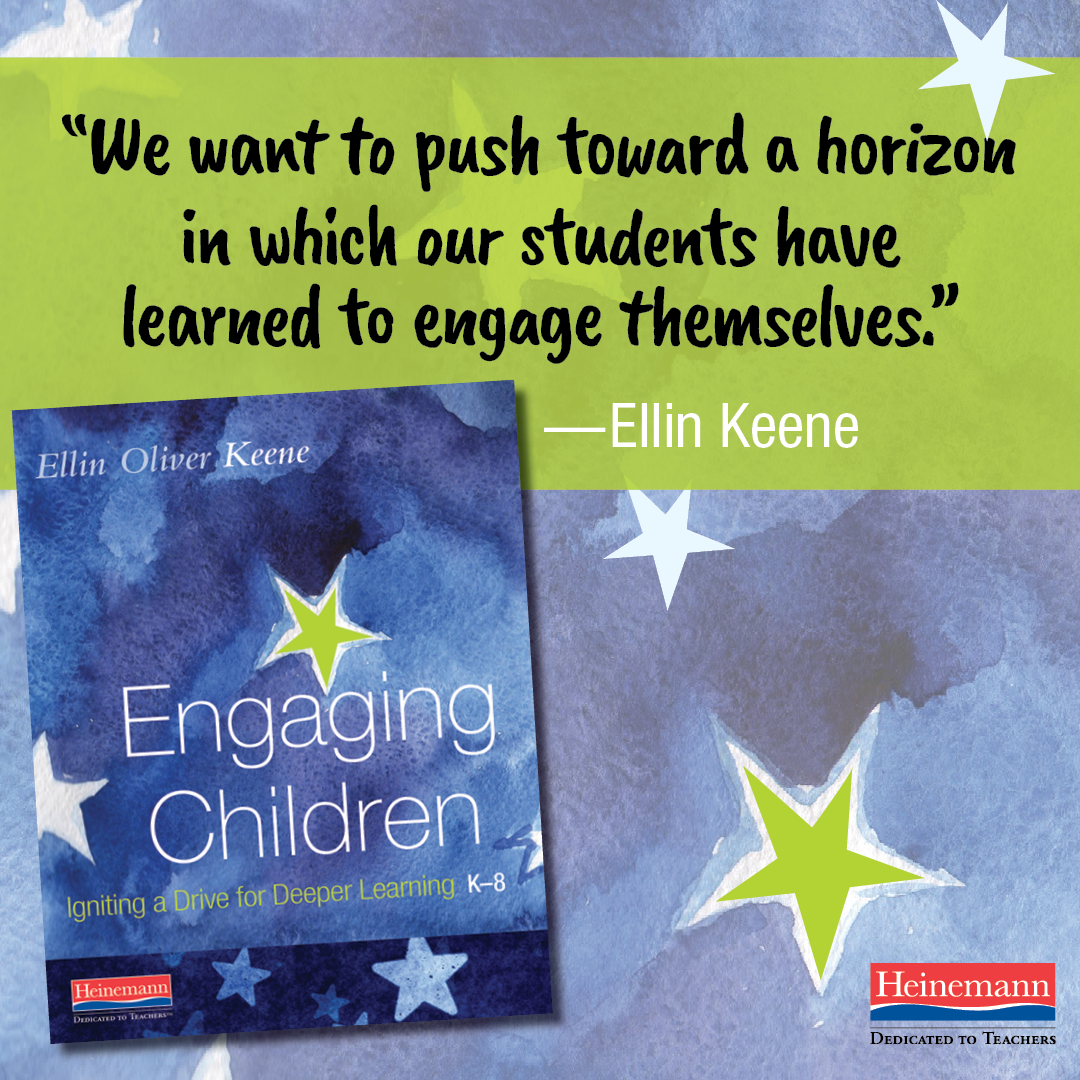
Since 2014, Ellin Oliver Keene has served as Chairperson for the Heinemann Fellows. This project, which just announced its upcoming third cohort, aims to amplify the voices of educators throughout the country. The action research undertaken by each Fellow explores a critical, compelling question of practice.
Since 2014, Ellin Oliver Keene has served as Chairperson for the Heinemann Fellows. This project, which just announced its upcoming third cohort, aims to amplify the voices of educators throughout the country. The action research undertaken by each Fellow explores a critical, compelling question of practice.
Ahead of the publication of Engaging Children: Igniting a Drive for Deeper Learning, Aeriale Johnson (2016-2018 Fellows class) and Jess Lifshitz (2014-2016 Fellows class) read and reacted to Ellin’s soon-to-arrive book. Their words about Engaging Children, appropriately, became its Foreword.
♦ ♦ ♦
Aeriale Johnson, kindergarten teacher, Washington Elementary, San Jose, California:
In Engaging Children: Igniting a Drive for Deeper Learning,Ellin Oliver Keene invites us to join her in plumbing the depths of engagement. Much like she does in To Understand, Ellin takes one question, one word, explores it from every possible angle and creates a new paradigm that has the power to shift children’s everyday experiences at school. Driven by her trademark respect for the humanity of children and a belief that they are infinitely capable, she compels readers, once again, to trust the power of listening to children and allowing them to do the heavy lifting.
Ellin turns her thinking into something tangible, something educators can grab onto and use straightaway. I finished the book on a Tuesday; I integrated the four pillars of engagement she illustrates—intellectual urgency, emotional resonance, perspective bending, and the aesthetic world—into my instruction on Wednesday.
"I finished the book on a Tuesday; I integrated the four pillars of engagement she illustrates into my instruction on Wednesday."
Throughout Engaging Children, Ellin invites readers to experience engagement for themselves. With each successive exercise, I felt myself beginning to truly understand the pillars of engagement. Having experienced a whirlwind of internal conflicts, emotions, and beauty, I was breathless (and in need of the dinner I’d forgotten to eat) by the end of the book. I was in “the flow.” I was engaged. Truly. I stood up, walked outside of mycoffee shop, took several deep breaths, and paced until I felt ready to tackle what Ellin writes is our responsibility as readers: a plan to act. I believe this is exactly what she intended.
Once you see authentic engagement, you cannot unsee it. On that Wednesday, when a kindergartner implored me to stop and commented, “This is really cute. I see a pattern. I understand what is happening,” in awe as I demonstrated decomposing numbers during a math lesson, I wondered if she was doing more than “being cute” herself, but having an aesthetic experience.
In Engaging Children, Ellin draws us into a “life of engagement” and then demonstrates how we can delineate our thoughts in one-on-one conferences, small groups, and whole groups in ways that provide children with the language they need to identify and describe their peak engagement, thus promoting replication and transfer.
Ellin is just the kind of thinker our profession needs. She has a thought process that leaves no stone unturned. She questions our collective assumptions and her own. Somehow, Ellin leads us closer to the answers while leaving us with more and more complex questions than which we began.
I think an excerpt quoted in the book sums up my lingering thoughts best:
In Engaging Children, (Ellin Keene) pulled me into a conversation I’d apparently been longing to have. It came at me with a force I will never forget and it began very simply. I looked at it. It looked at me and all it said was, “Me too!” (Robert Krulwich on page 161)
Me too! I had been pondering what engagement looks like, really, because the kid who spins on our meeting rug as if propelled by a centripetal force every day actually is engaged. Bring Engaging Children to your coffee shop and sit down for an engaging conversation with Ellin Oliver Keene to crack open the nuances of another word: engagement.
♦ ♦ ♦
Jess Lifshitz, fifth-grade teacher, Meadowbrook Elementary, Northbrook, Illinois:
This book is a gift to both teachers and students. The entire premise of this book, that we, as teachers, can create conditions that will help our students to learn to engage themselves in their own learning, is both brilliant and refreshing. Not only does Ellin suggest that it is possible for us to empower our students to learn how to engage and reengage as learners but she also provides us with practical and powerful suggestions of how to do just that.
In a world that is increasingly focused on asking teachers to use programs that center on isolated skill practice and scripted lessons to teach our students, Ellin reminds us of what the research says. If kids aren’t engaged, they will not remember their learning for as long or be able to apply it to new situations. With that in mind, Ellin returns the students themselves to the center of their own learning and asks teachers to join her on a journey toward helping students help themselves to once again become engaged learners.
By looking at students’ need to know, the emotions they feel as learners, their desire to wrestle with conflict, and their inclination toward creating a more beautiful and just world, Ellin shows us all how to create spaces where children learn how to learn and where they are driven by an internal force that is much more powerful than the simple compliance we have relied on for too long.
Want to learn more about Engaging Children?



